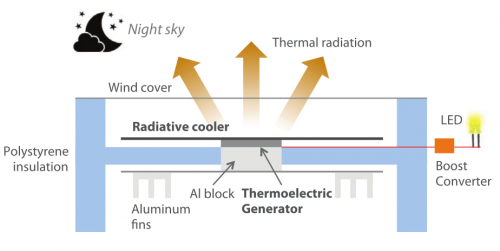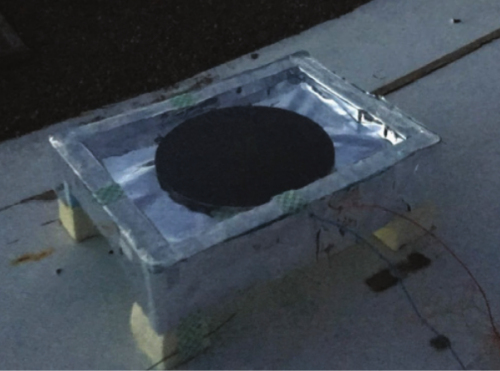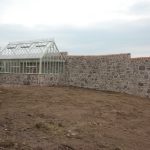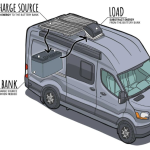Night-time power generation analogous to photovoltaics would be an enabling capability for applications such as lighting and wireless sensors. We demonstrate a low-cost power generation device based on thermoelectric generators where the cold side radiates heat to the cold of space by facing the night sky. The power generated is sufficient to maintain a LED at night, enabling battery-free off-grid lighting.
***
A large fraction of the world’s population still lacks access to electricity, particularly at night when photovoltaic systems no longer operate. Lighting solutions for resource-constrained, off-grid communities have drawn much global interest with a range of approaches implemented. Solar lights have made progress at this task but, as lighting demand peaks at night, require the coupling of photovoltaic modules to a battery, driving up costs. A modular way to generate electricity at night without the need for storage would thus have direct and significant implications for lighting applications.
A significant fraction of thermal radiation from a sky-facing surface can pass through the atmosphere and reach outer space, enabling passive radiative cooling of the surface to well below the ambient air temperature. We demonstrate a low-cost strategy to harness the cold of space through radiative cooling to generate electricity with an off-the-shelf thermoelectric generator. Unlike traditional thermoelectric generators, which convert waste heat into electricity, our device couples the cold side of the thermoelectric module to a sky-facing surface that radiates heat to the cold of space and has its warm side heated by the surrounding air, enabling electricity generation at night.
The Device
The device consists of a polystyrene enclosure covered in aluminized mylar to minimize thermal radiation from the enclosure and an infrared-transparent wind cover made from 12.5 mm-thick low-density polyethylene previously used in radiative cooling implementations. The thermal emitter consists of 200 mm aluminum disk painted with a commercial black paint. The disk is adhered with heat transfer paste to the cold side of a commercial thermoelectric module. The hot side of the module is coupled to a small aluminum block adhered to a 200 mm aluminum disk with multiple fins outside the enclosure. The entire device sat on a table approximately 1 meter above roof level.
We tested performance outdoors on a rooftop in Stanford, CA, USA in late December 2017 under clear-sky conditions with a dew point temperature between 1 and 3 degrees C during the hours of testing. The device was taken outside shortly after 18:00 h, when the sky was dark. A temperature difference between the two sides of up to 2 degrees C is observed during testing. At the maximum power point, nearly 0.8 mW of power is generated by the thermoelectric module. Normalizing to the area of the radiative cooler this corresponds to 25 mW/m 2 of power generation capacity.
While the power generated from this demonstration may seem, at first glance, modest, we highlight one application here: lighting. We show that the device can directly power a light emitting diode, thereby generating light from the darkness of space itself. We estimate that the LED was operating at approximately 10% of its maximum brightness. In favorable conditions, where the ambient air temperature is warm and the dew point low (summer conditions in a Mediterranean or desert climate), we calculated that power generation of 0.5 W/m 2 may be achievable.
Modular
We emphasize that this result does not represent the ultimate limit of performance for night-time power generation using thermoelectric modules, but is instead intended to point to the practical performance capability of a system similar to the one used here. In principle, the inherent modularity of this approach allows us to scale the system’s size depending on energy needs in a manner similar to photovoltaic systems. Our system uses low-cost, off-the-shelf, commodity components (less than $30 USD for our initial proof of concept demonstration).
Another avenue for improved performance is to optimize the area of the radiator relative to the area of the thermoelectric module, as has been done in solar thermoelectric generators. Related to this, we note that the radiative cooling surface used here is black over solar wavelengths, and thus the device tested could function as a solar thermoelectric generator during the day-time.
Quoted from: Raman, Aaswath P., Wei Li, and Shanhui Fan. “Generating Light from Darkness.” Joule 3.11 (2019): 2679-2686.







